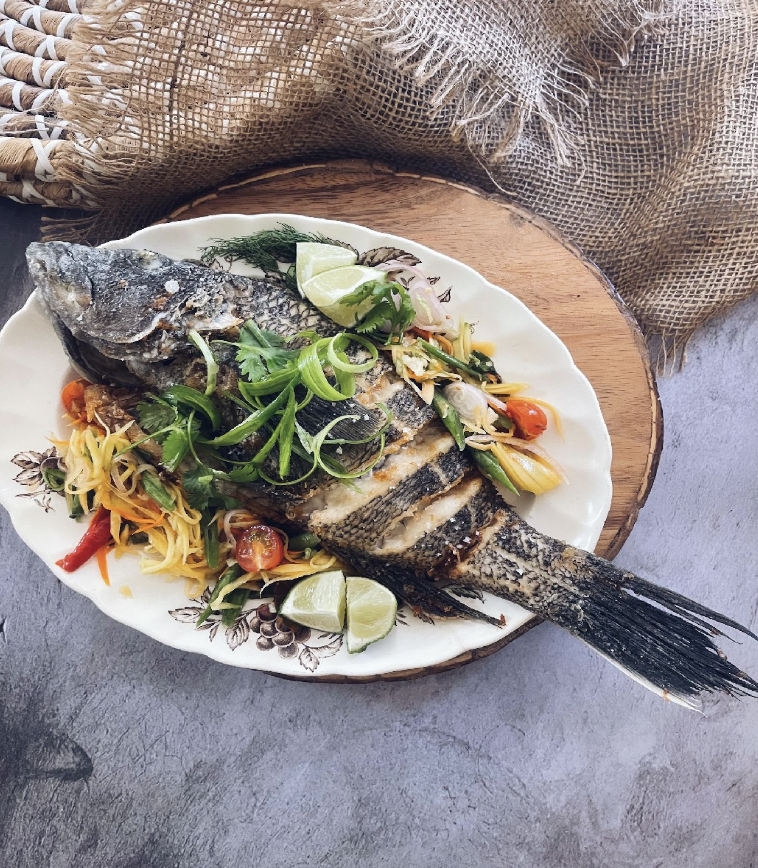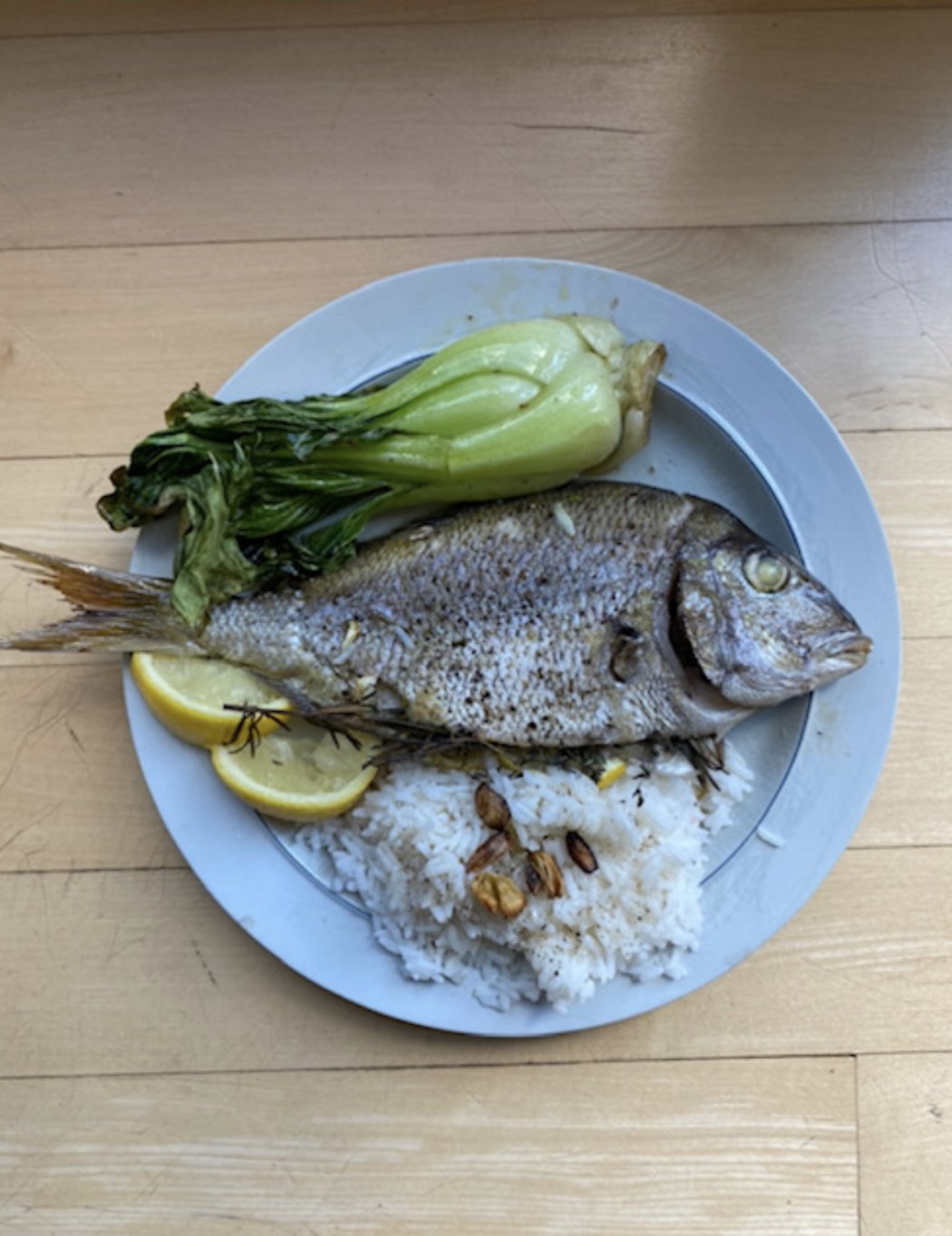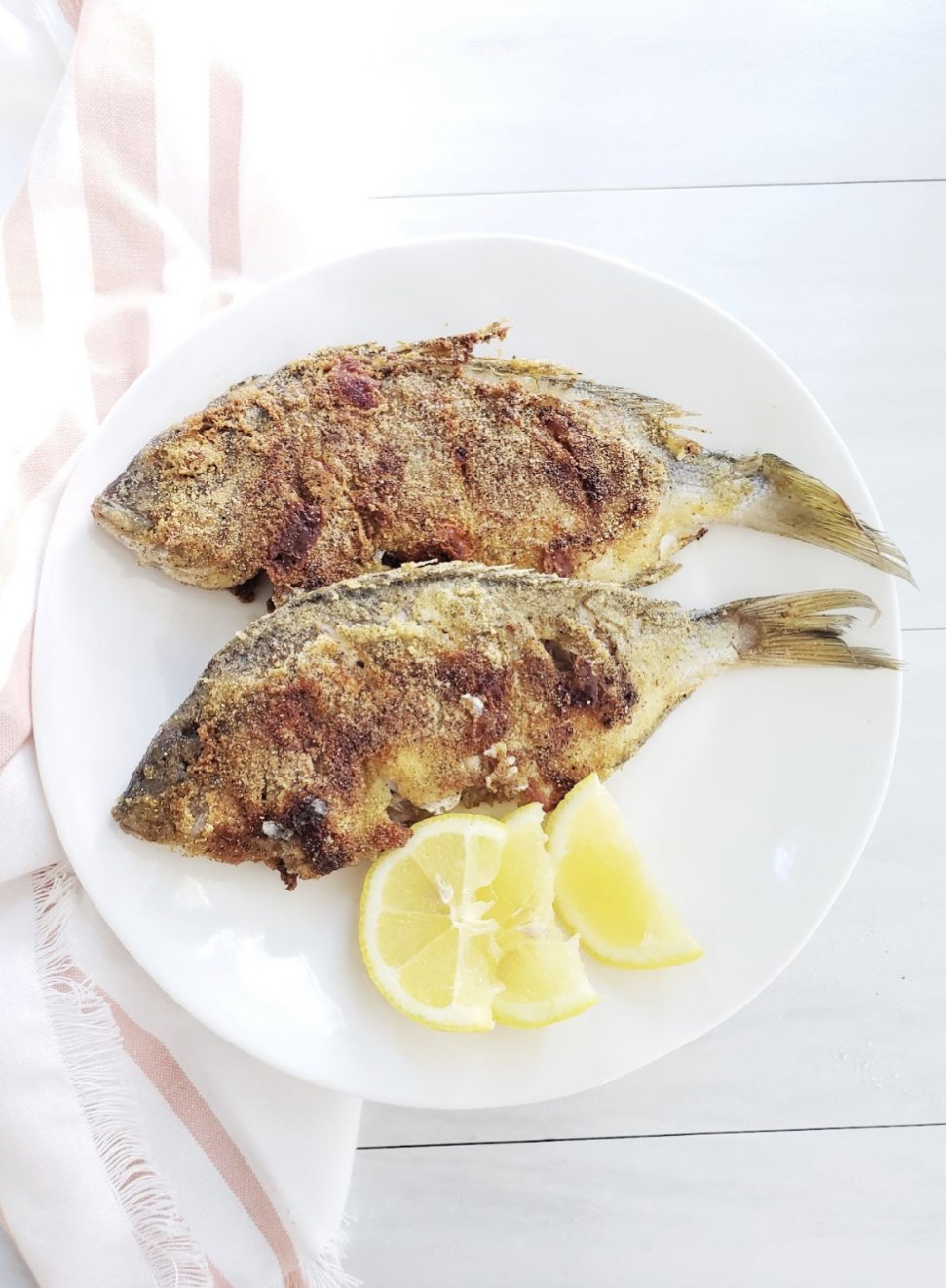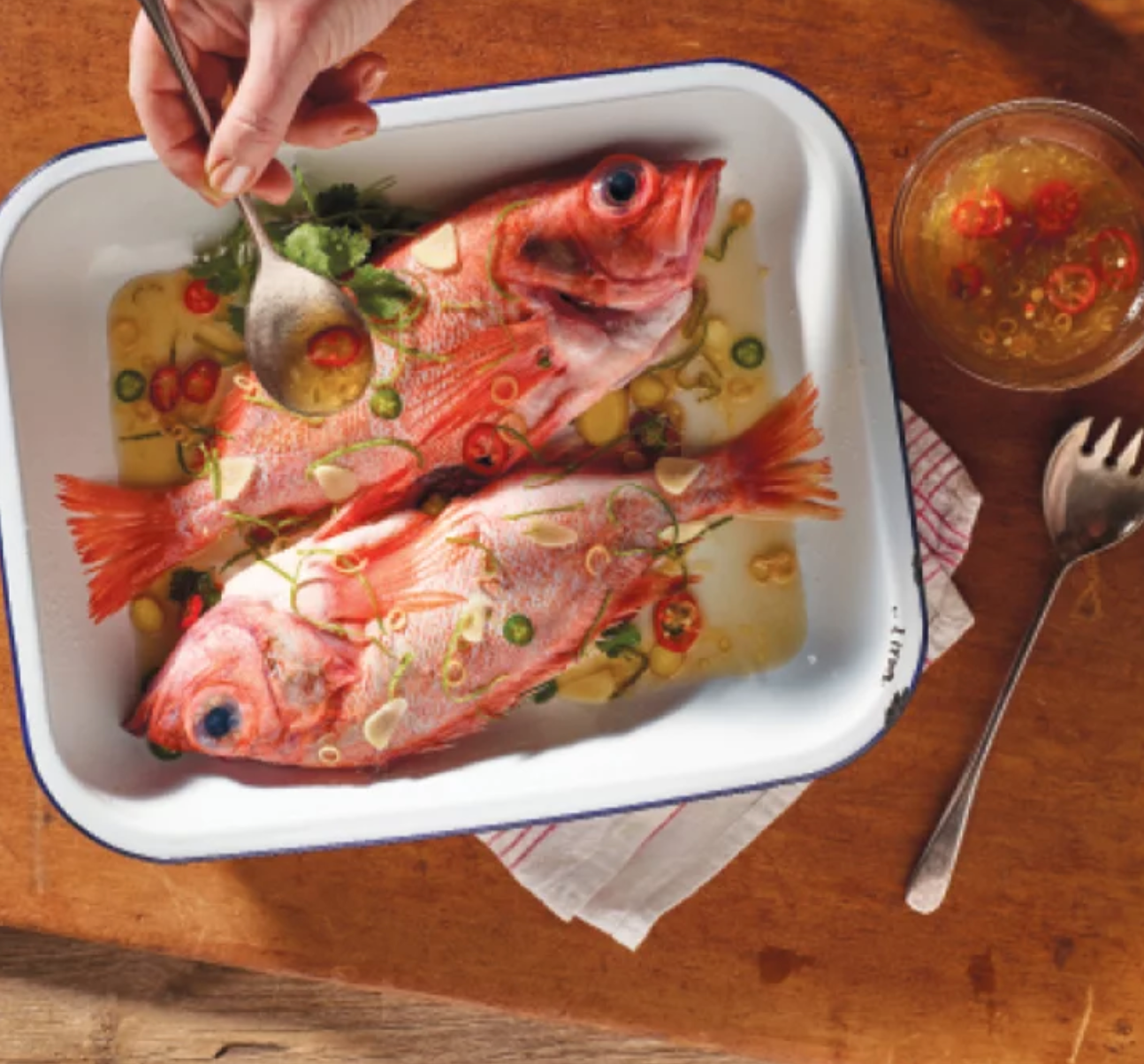Recipe courtesy of Stacy Deetz at the Hangry Kitchen. Click the button below for the recipe.
Whole Baked Rock Cod
This recipe is from Elise Smith as part of the Massachusetts Seafood Ambassador Program led by Eating with the Ecosystem.
Time: 45 min
Serves: 6
Ingredients
· 1 whole rock cod, gutted (about 2 lbs)
· 2 tablespoons frying oil
Seasoning A:
· ¾ teaspoon salt
· 1 tablespoon rice wine
· 2 teaspoon sesame oil
· 1 tablespoon frying oil
· 1 ¾ teaspoon five-spice powder
Shredded Ingredients:
· 3 pieces of bacon
· 1 leek
· 4 slices ginger
· A few pinches or coriander
Seasoning B:
· ¼ cup chicken stock
· 1 ½ tablespoon rice wine
· 1 tablespoon sugar
· ¼ cup light soy sauce
· 2 teaspoons dark soy sauce
· 2 tablespoons frying oil
Directions
Cut the fish in half lengthwise, cutting right up through the head but do not sever along the top of the back so the fish can be pressed out flat in one piece. Remove the gills. Rinse fish well.
Rub the fish all over with seasoning A and let sit 5 or 10 minutes.
Heat a baking pan in the oven at 425 degrees F for a few minutes, remove baking pan and add frying oil. Carefully spread the fish skin upwards on the pan and arrange the shredded ingredients on top. Pour Seasoning B ingredients over fish. Bake at 425 degrees for about 30 minutes - baste the fish a few times while it cooks.
We enjoyed this main course with roasted potatoes and cherry tomatoes, sautéed green beans, a massaged kale salad and Spanish rice.
These recipes are brought to you as part of the Massachusetts Seafood Ambassador program led by @eating_with_the_ecosystem. The program is made possible by funding provided by commercial fishermen of MA from permit fees at no additional cost to the fishermen via @massmarinefisheries Seafood Marketing Grant Program.
Crispy Whole Fried Black Sea Bass with Easy Spicy Thai Salad
This recipe is from Aliya Zarei as part of the Massachusetts Seafood Ambassador Program led by Eating with the Ecoystem.
Time: 45 minutes
Serves: 4
Ingredients
For the fish:
· 1 whole black sea bass
· ½ cup corn starch & ½ cup rice flour (rice flour is optional but it gives nice, lighter crispy batter. If not using rice flour, increase amount of corn starch)
· Salt
· Oil for deep frying
For the Thai salad:
· Your choice of fruits/veg i.e. young papaya, cucumber, carrot, young mango. I used half of young papaya in this recipe
· Sugar (palm sugar if you have, otherwise mix brown and white sugar) - adjust according to your preference. I used one small cube of palm sugar.
· 2 cloves of garlic
· 3 hot chili peppers (or sub with pepper flakes). Feel free to reduce or increase amount accordingly
· 1 tablespoon fish sauce - adjust according to your preference
· Juice 1.5 limes - adjust according to your preference
· 1 shallot
· Your choice of herbs, such as Thai basil or Italian basil, mint, cilantro, dill
· Optional: 1 tablespoon chopped peanuts, fermented fish sauce, ½ tsp dried shrimp or anchovies
Directions
For the fish:
Score both sides of the fish (deep, all the way to the bones) - this will help fish cook evenly. Generously season with salt and then lightly coat with flour mix. Carefully slide fish into hot oil (don’t worry if the fish is slightly bigger than your pan/wok, just be sure to tilt the pan/wok and baste those uncovered areas with hot oil). Use a tong and wide/large spatula to carefully flip fish. Cook the fish for about 15-17 minutes in total or until golden and crisp.
For the Thai salad:
Julienne and thinly slice your choice of fruits/veg i.e. young papaya, cucumber, carrot, young mango etc. Use a pestle & mortar to pound sugar, garlic and pepper. Once sugar is crushed, add the rest of the ingredients and pound them together (lightly, only to bruise and release the flavors and tomato juices, we are not making a paste). If you don’t have a pestle and mortar, you can simply chop the aromatics (shallot, garlic, hot chili pepper or sub with pepper flakes) followed by mixing the seasonings (sugar, fish sauce, lime juice) before adding the veggies in and let them rest in the fridge for at least 30 minutes before serving.
Assembly:
Serve fish overtop Thai salad. Optional: sprinkle with chopped peanuts, drizzle with fermented fish sauce and dried shrimp or anchovies.
These recipes are brought to you as part of the Massachusetts Seafood Ambassador program led by @eating_with_the_ecosystem. The program is made possible by funding provided by commercial fishermen of MA from permit fees at no additional cost to the fishermen via @massmarinefisheries Seafood Marketing Grant Program.
Whole Roasted Porgy
This recipe is from Craig Fear as part of the Massachusetts Seafood Ambassador Program led by Eating with the Ecosystem.
Directions
1. Rub fish including the cavity with olive oil and lemon juice.
2. Stuff cavity with garlic, lemon slices, and fresh herbs.
3. Place in a baking dish and roast at 425 degrees for 15—20 minutes.
4. It’s done when the flesh flakes easily with a fork.
These recipes are brought to you as part of the Massachusetts Seafood Ambassador program led by @eating_with_the_ecosystem. The program is made possible by funding provided by commercial fishermen of MA from permit fees at no additional cost to the fishermen via @massmarinefisheries Seafood Marketing Grant Program.
Pan Fried Scup
This recipe is from Chrissy Carroll as part of the Massachusetts Seafood Ambassador Program led by Eating with the Ecosystem.
Time: 20 minutes
Serves: 2 (assumes fish are on the smaller side)
Ingredients
· 2 whole scup, gutted and sealed
· 2 tablespoons cornmeal
· 2 tablespoons cornstarch
· 1/4 teaspoon salt
· 1/4 teaspoon chili powder
· 1/4 teaspoon garlic powder
· 3 tablespoons avocado oil
Directions
Score the skin of the fish with a few cuts.
In a small bowl, mix the cornmeal, cornstarch, salt, pepper, chili powder, and garlic powder together. Rub the seasoning all over both sides of the fish.
Heat the avocado oil in a large skillet over medium heat. Place the fish in the hot oil. Pan fry for 5 minutes per side, or until the outside is golden brown and the fish is cooked through. Enjoy!
These recipes are brought to you as part of the Massachusetts Seafood Ambassador program led by @eating_with_the_ecosystem. The program is made possible by funding provided by commercial fishermen of MA from permit fees at no additional cost to the fishermen via @massmarinefisheries Seafood Marketing Grant Program.
Air Fryer Black Sea Bass
This recipe is courtesy of Snacking in Sneakers as part of the Massachusetts Seafood Ambassador Program led by Eating with the Ecosystem. Click the button below to access recipe.
These recipes are brought to you as part of the Massachusetts Seafood Ambassador program led by @eating_with_the_ecosystem. The program is made possible by funding provided by commercial fishermen of MA from permit fees at no additional cost to the fishermen via @massmarinefisheries Seafood Marketing Grant Program.
Sheet Pan Roasted Black Sea Bass
This recipe is from Abigail Rose as part of the Massachusetts Seafood Ambassador Program led by Eating with the Ecosystem.
Time: 45—60 minutes
Serves: 4
Ingredients
· 2 whole black sea bass
· 2 tablespoons olive oil or any high heat oil
· garlic, to taste
· salt, to taste
· black pepper, to taste
· 1 sprig fresh rosemary
· 1 sprig fresh thyme
· 1 bunch chives
· 1 lemon, cut in half
Directions
Preheat oven to 450 degrees.
Gut fish, remove fins, and descale. Smother fish with olive oil, and sprinkle with garlic, salt, pepper, rosemary, thyme, and chives. Squeeze half a lemon into each fish cavity.
Roast for 20—30 minutes, until fish is cooked through.
These recipes are brought to you as part of the Massachusetts Seafood Ambassador program led by @eating_with_the_ecosystem. The program is made possible by funding provided by commercial fishermen of MA from permit fees at no additional cost to the fishermen via @massmarinefisheries Seafood Marketing Grant Program.
Grilled Whole Black Sea Bass
This recipe is courtesy of Jenny Shea Rawn as part of the Massachusetts Seafood Ambassador Program led by Eating with the Ecosystem. Click the button below to access recipe.
These recipes are brought to you as part of the Massachusetts Seafood Ambassador program led by @eating_with_the_ecosystem. The program is made possible by funding provided by commercial fishermen of MA from permit fees at no additional cost to the fishermen via @massmarinefisheries Seafood Marketing Grant Program.
Chili Lime Marinated Grilled Acadian Redfish
Pan Roasted Acadian Redfish Recipe
GRILLED BLUEFISH
Recipe courtesy of Eating with the Ecosystem from Simmering the Sea.
If you enjoy this recipe please consider buying the full cookbook to experience the full suite of recipes for all our favorite local seafood species while also supporting Eating with the Ecosystem!
RECIPE
Serves 4
INGREDIENTS
¼ cup soy sauce
¼ cup lime juice
¼ cup grapefruit juice
1 tablespoon sugar
2 tablespoons grated ginger
4 bluefish fillets, skin on, washed and patted dry
Lemon wedge
INSTRUCTIONS
Make marinade by whisking all ingredients together except for fish and lemon. Place fish in marinade, cover, and refrigerate for 2 to 3 hours. Remove fish and pat dry. Discard marinade. Grill over charcoal for 3 to 4 minutes on either side. Remove skin by slowly pulling it away from the meat, then serve bluefish with a lemon wedge.
This preparation can also be used with mackerel, herring, or other oily fish.
MACKEREL WITH TOMATO SALAD
Recipe courtesy of Eating with the Ecosystem from Simmering the Sea.
If you enjoy this recipe please consider buying the full cookbook to experience the full suite of recipes for all our favorite local seafood species while also supporting Eating with the Ecosystem!
RECIPE
Serves 4
INGREDIENTS
SALAD
1 pint cherry tomatoes, sliced in half lengthwise
1 small red onion, thinly sliced
½ cup pitted olives, preferably Kalamata
3 tablespoons cilantro, finely chopped
1 lemon, juiced
2 tablespoons extra-virgin olive oil
FISH
4 mackerel fillets, skin on
Kosher salt to taste
2 tablespoons extra-virgin olive oil
INSTRUCTIONS
SALAD
Mix all ingredients together and let marinate in refrigerator for about 30 minutes.
FISH
Season fish with salt. Add oil to a skillet or sauté pan over medium heat. Place fish skin-side down in pan and press down so fish remains flat and achieves a crispy skin. Cook for 3 to 4 minutes and flip. Cook for an additional 1 to 2 minutes. Serve over salad.
You can also prepare this dish with herring, sardines, smelt, or other small fish.
CRISPY FRIED FLOUNDER, CHINESE-STYLE
Recipe courtesy of the Woks of Life. Click the button below for the recipe.
“LIMAN STYLE” WHITING
Recipe courtesy of Noah Cain for a Cook a Fish, Give a Fish class. Click the button below to access the recipe.
During the class chef Noah showed us a very cool way to butterfly and remove the bones from the whiting. This method is the same method that is more commonly used on sardines. Click this link to learn how to do it. If you can’t find whiting you could also use any mild flavored flaky white fish.
JING LOU YU (CANTONESE-STYLE STEAMED SEA BASS)
Recipe courtesy of Saveur Magazine. Click on the button below to access the recipe.
GRILLED WHOLE SCUP WITH SUMMER VEGETABLES
Recipe courtesy of Jason Timothy for a Cook a Fish, Give a Fish class. Click the button below to access the recipe.
scup brining
BAKED FLOUNDER WITH PANKO BREADCRUMBS
Recipe courtesy of Rizwan Ahmed for a Cook a Fish, Give a Fish class. Click the button below to access the recipe.
This recipe calls for a whole local flounder and asks you to filet it. Follow this guide to learn how to filet your flounder. You can also use already filleted fish.
PAN FRIED FISH: CHINESE WHOLE FISH RECIPE
Recipe courtesy of the Woks of Life. Click the link below to access the recipe.
This recipe is great with scup, black sea bass, tautog, acadian redfish, sea robin, or any other whole local fish.
Winter Citrus Roasted Whole Black Sea Bass
Roasted Scup with Briny Herb Sauce
Recipe courtesy of Edible Boston magazine. Click the link below to access the recipe.
Photo by Michael Piazza





















